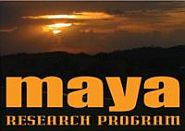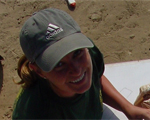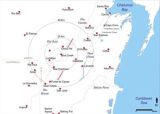
Chapter 1 | Chapter 2

Welcome to the Maya Research Program’s 2011 field season! First off – the Maya Research Program would like to thank Thomas Riddle and Wes Dodgens for this fantastic opportunity to share our research and collaborate with Indy in the Classroom. Thank you both for all of your time and patience!
So what exactly is the Maya Research Program (MRP) and what is it that we do? MRP is a non-profit organization (501c3) that sponsors archaeological and ethnographic research in Middle America (Mexico, Belize, Guatemala, and Honduras). The “501c3” corporate designation means that the funds that MRP raises go directly back into our research (in other words – the staff all volunteer their time – we are not paid!). Thanks to MRP – we are able to study and document the cultures of both the past (archaeology) and the present (ethnography). MRP was established in 1992 by Dr. Thomas H. Guderjan and there are two major projects (and other small ones – but I’ll focus on the largest two). The first project is MRP’s ethnographic field school that is run by Dr. Grace Bascope and is located in the village of Yaxunah, Mexico. The village is in the Yucatan Peninsula adjacent to the ancient Maya city of Yaxunah. Over the past 20 years, Dr. Gascope and her students have lived and worked in this wonderful and beautiful village and have documented many, many aspects of modern Maya culture.
The second project is MRP’s archaeological field school and it is located in northwestern Belize. Belize is located just south of Mexico , adjacent to Guatemala, and is a small, democratic country of about 350,000 people. It used to be called “British Honduras” but gained its independence from Britain in 1981. MRP’s archaeological project is located in a small village of about 800 people called Blue Creek. The village is named after the nearby river called “Rio Azuel” (Azuel is Spanish for “Blue” and “Rio” means “River” or “Creek” in Spanish). The people who live here are Mennonite, are of German descent, and speak “low” German as well as Spanish and English. “Low” German is a local dialect (or variation) of “high” German. “High” German is what you would hear spoken in Germany. There are many, many differences between the two languages – so if you speak “high” German you would not understand a lot of what is said in “low” German. The village of Blue Creek was established fifty-two years ago when a small group of Mennonite settlers migrated from central Mexico to establish a new colony here in Belize. Their culture is somewhat similar to the Amish (Mennonites are also Anabaptists) but the Mennonites living in Blue Creek are more progressive and utilize modern conveniences such as rubber tires, cars, tractors, electricity, cell phones, computers, etc. There is another village called Shipyard nearby that is much more traditional and they rely on horse and buggies, metal or stone tires, and do not utilize modern technologies, such as electricity, etc. in their homes. Overall, the Mennonites are farmers, ranchers, and business men and women. In fact, one of the largest construction companies in Belize is owned by Blue Creek Mennonites.
In 1992, Dr. Guderjan began exploring the ancient Maya ruins near the Blue Creek village and located an ancient Maya city that he later named Blue Creek . Each year since MRP has received a permit from the National Institute of Culture and History (NICHE) of Belize that allows MRP to conduct archaeological investigations at the site of Blue Creek and other ruins in our permit area (which measures about 500 square kilometers). An archaeologist must have a government permit to excavate ancient ruins in Belize. Archaeological ruins are a very finite and endangered resource and must be conserved. In fact - NICHE’s motto is “preserving the past for the future.” In addition, archaeological excavation – by its very nature - is a destructive process and, as a result, must be VERY carefully conducted and VERY well documented. Archaeologists create incredibly detailed maps, take photographs, 3D scans, etc. and write very descriptive notes when they excavate. Archaeologists do this because artifacts have no real meaning without a proper provenience (or context). In other words, if someone “loots” a site (or removes artifacts without detailed documentation of the provenience or context) - the data are lost forever because we don’t know exactly where the artifacts came from.
An artifact has very little meaning by itself – it is the artifact in conjunction with its provenience (or context) that provides archaeologist s with insights into the past. For example, look around your house and consider all the items on display there. You probably have family photos, items passed down from your parents and grandparents, trophies, etc. If 1000 years from now an archaeologist found those items in the ruins of your home – he or she would understand the context (or provenience) and know they were valued items curated by your household. Now – imagine someone broke into your house, took those items out of that context, and tossed them in a trash dump. If 1000 years later an archaeologist finds them in a dump – he or she will think these items were simply trash. So the moral of the story is that an artifact can have very different meanings depending on its context or provenience (i.e. - where the artifact was found).
Back to the Top
Chapter 1 | Chapter 2






